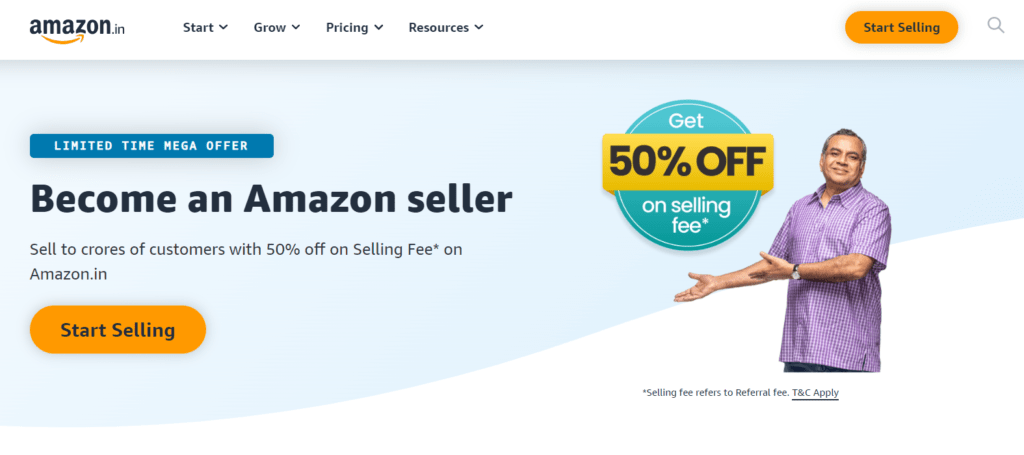These days, selling opportunities are practically limitless, thanks to the vast expanse of the internet. And speaking of the internet, we can’t ignore the giant in the room: Amazon, the planet’s biggest online retailer.
In this highly competitive market, having a solid Amazon selling strategy is essential if businesses want to thrive.
With the right strategy, businesses can boost their revenue and stand out. It’s like having a secret weapon that sets you apart.
So, buckle up and get ready to dive into the world of Amazon selling strategies, where success awaits those who seize the opportunity!
Table of Contents
Key Takeaways
- Optimize Listings: Create appealing product listings with clear images, descriptions, and keywords for better visibility.
- Use Amazon Advertising: Employ Sponsored Products and other ads to target customers and enhance visibility.
- Prioritize Reviews: Encourage positive reviews and address negative feedback promptly to build trust.
- Stay Competitive: Monitor competitors, adjust strategies, and innovate.
Why Selling on Amazon is Essential for Businesses
As one of the world’s largest e-commerce platforms, Amazon allows businesses to sell their products on a massive scale.
With over 300 million active users worldwide, Amazon represents a significant customer base that businesses can tap into. Selling on Amazon also allows businesses to reach a global audience they may not have access to.
Setting up an online store on Amazon is relatively straightforward and requires minimal investment compared to building a standalone e-commerce website.
Amazon provides sellers various tools and resources to manage their online store, including inventory management, order fulfillment, and customer service support.
When selling on Amazon, businesses can leverage Amazon’s reputation as a trusted retailer, gaining customer trust and increasing the likelihood of sales.
Amazon offers various advertising options businesses can use to increase product visibility and drive sales, including sponsored products, brands, and displays.
Overall, selling on Amazon is essential for businesses wanting to reach a vast customer base, expand their global reach, and stay competitive. By adopting an effective Amazon selling strategy, businesses can revolutionize their sales and achieve significant revenue growth.
Understanding the Amazon Marketplace
Amazon is the world’s largest online retailer, offering a vast marketplace for sellers to reach millions of customers worldwide. The Amazon marketplace is a complex ecosystem with multiple selling programs, policies, and rules to navigate. To succeed on Amazon, it’s crucial to have a deep understanding of the marketplace dynamics and competition.
There are two main seller programs on Amazon.;
- The first is the Individual Seller Program, suitable for small sellers who want to sell fewer than 40 items per month.
- The second is the Professional Seller program, ideal for larger sellers who want to sell more than 40 items per month.
Both programs have benefits and drawbacks, and choosing the program that best fits your business model and sales goals is essential.

The Key Elements of Successful Amazon Selling
Successful selling on Amazon requires a strategic approach that encompasses several key elements:
- Competitive pricing: Pricing your products competitively is critical to attracting customers and standing out.
- Optimized product listings: Optimizing your product listings with relevant keywords, high-quality images, and a compelling description can increase visibility and drive sales.
- Efficient inventory management and fulfilment: Managing your inventory efficiently and choosing the right fulfilment options can improve your seller metrics and meet customer expectations.
- Effective advertising: Leveraging Amazon’s advertising options can boost your product visibility and drive sales.
- Building a strong brand reputation: Providing exceptional customer service, responding to customer feedback, and managing product reviews effectively can help build a strong brand reputation on Amazon.
- Continuous optimization: Staying ahead of the competition requires continuous optimization of your selling strategy on Amazon, adapting to market trends and customer preferences.
Incorporating these elements into your Amazon selling strategy can improve your chances of success in the marketplace.
Researching Your Target Market on Amazon
Conducting thorough market research on Amazon is crucial for businesses to identify potential customers, analyze their needs and preferences, and uncover market trends. By gaining insights into your target market, you can develop an effective selling strategy on Amazon that caters to their specific needs and preferences.
Several tools and techniques can be used for market research on Amazon. One such tool is Amazon’s search bar, which provides valuable insights into customer search behaviour and allows you to identify popular search terms relevant to your product category.
Another useful technique is to analyze customer reviews of products similar to yours. This can provide valuable insights into what customers like and dislike about similar products and help you identify areas where you can differentiate your product.
You can use Amazon’s sales data to gain insights into market trends and identify popular products in your category. This can help you make informed decisions about pricing, product features, and other elements of your selling strategy on Amazon.
With the help of these tools and techniques, you can conduct comprehensive market research on Amazon and gain valuable insights into your target market. This can help you develop an effective selling strategy on Amazon and stay ahead of the competition.
Optimizing Your Amazon Product Listings
Product visibility is one of the key factors that can greatly impact your success on Amazon. Optimizing your product listings is essential to ensuring that your products appear at the top of Amazon’s search results and attract potential customers.
Here are some tips for optimizing your Amazon product listings:
- Provide a clear and concise product title: The first thing customers see when searching for a product on Amazon is the product title. Ensure your product title is descriptive, accurate, and includes relevant keywords. Avoid using promotional language or irrelevant information in the product title.
- Write a compelling product description: Your product description should provide comprehensive details about your product, including its features, benefits, and specifications. Use bullet points to make it easy to read and highlight the unique selling points of your product. Avoid using technical jargon or language that customers may not understand.
- Include high-quality product images: High-quality product images can make a big difference in attracting customers and increasing sales. Use high-resolution images that showcase your product from multiple angles and contexts. Avoid using stock images or images with watermarks or promotional text.
- Use relevant keywords: Use relevant keywords throughout your product listing to make it easier for customers to find your product. Include keywords in the product title, description, and bullet points. But use them naturally and avoid keyword stuffing, which can harm your product’s visibility.
- Encourage positive customer reviews: Positive reviews can significantly impact a product’s visibility and sales. Encourage customers to leave feedback by providing exceptional customer service and following up with them after the purchase. Respond to negative feedback promptly and professionally to show that you value customer satisfaction.
Optimizing your Amazon product listings can help you attract potential customers, increase sales, and improve your overall performance on Amazon. Regularly review and update your product listings to stay competitive and adapt to changing market trends.

Managing Inventory and Fulfillment on Amazon
Efficiently managing inventory and fulfilment is crucial for the success of any Amazon selling strategy. As a seller, keeping track of your inventory is essential to avoid stockouts and overselling. A well-managed inventory can improve product visibility, ratings, and sales velocity.
Forecasting and Replenishment
Predicting customer demand is an essential element of inventory management. Amazon provides several tools to help sellers forecast demand and replenish inventory efficiently.
The Inventory Planning dashboard provides recommendations on stock replenishment based on historical sales data, current inventory levels, and seasonal trends.
Sellers can also use Forecastly, RestockPro, and Sellics to automate inventory forecasting and replenishment. These tools use algorithms to analyze sales data, predict demand, and recommend optimal inventory levels.
Choosing the Right Fulfillment Option
Amazon offers several fulfilment options, including Fulfillment by Amazon (FBA), Merchant Fulfilled Network (MFN), and Seller Fulfilled Prime (SFP). Choosing the right option depends on several factors, including product size and weight, shipping rates, and target customers.
FBA is a popular option that allows sellers to store their products in Amazon’s warehouses. Amazon takes care of shipping, handling, and customer service. FBA sellers benefit from Amazon’s Prime delivery speed and customer trust.
MFN is a self-fulfilment option where sellers handle their inventory and shipping. This option suits low-volume sellers who want more control over their inventory and shipping costs.
SFP is a hybrid option that allows sellers to fulfil their Prime orders using their warehouses or third-party logistics providers. This option offers the benefits of FBA, including Prime eligibility, while allowing sellers more control over their inventory and shipping costs.
Maintaining High Seller Metrics
Amazon holds sellers accountable for maintaining high-performance metrics, including order defect rate (ODR), late shipment rate (LSR), and cancellation rate (CR). These metrics indicate customer satisfaction levels and can impact a seller’s visibility and eligibility for programs like Buy Box.
Sellers can improve their metrics by providing accurate product descriptions, timely shipping, and excellent customer service. It is also crucial to monitor feedback and respond promptly to negative reviews.
By following these inventory and fulfilment best practices, sellers can optimize their Amazon selling strategy and provide a seamless customer experience.

Pricing Your Products Competitively on Amazon
Pricing your products competitively on Amazon is crucial to attracting customers and stay ahead of the competition. This section will discuss some techniques for competitively pricing your products on Amazon.
Dynamic Pricing Tools
Dynamic pricing tools can help you adjust your prices based on market trends, competitor prices, and other factors. These tools can help you stay competitive and maximize your profits on Amazon. Some popular dynamic pricing tools include Informed.co, Feedvisor, and RepricerExpress.
Monitor Competitor Prices
Monitoring your competitors’ prices can give you valuable insights into market trends and help you adjust your prices accordingly. You can use tools like CamelCamelCamel or Keepa to track your competitors’ prices and get alerts when they change their prices.
Offer Competitive Shipping
Shipping costs can significantly impact customers’ purchasing decisions on Amazon. If your product price is higher than your competitors, you can offer free or low-cost shipping to make your product more appealing to customers.
Amazon’s Buy Box
The Buy Box is a coveted spot on Amazon where customers can add a product to their cart directly from the product detail page. Winning the Buy Box can significantly increase your product sales. To win the Buy Box, your product price must be competitive, and you must meet Amazon’s performance metrics, such as fulfilling orders on time and maintaining a high seller rating.
By implementing these strategies, you can price your products competitively and increase your sales on Amazon.
Harnessing the Power of Amazon Advertising
Amazon advertising is a powerful tool to help you promote your products to a wider audience and boost your sales. Advertising options vary from Sponsored Products and Sponsored Brands to Sponsored Displays, each with advantages and costs. With over 310 million active users, Amazon’s advertising platform provides an excellent opportunity to increase your product’s visibility and profitability.
Understanding Amazon’s Advertising Options
Sponsored Products are keyword-targeted ads that appear in search results, product detail pages, and similar products. With Sponsored Products, you pay per click and are only charged when a customer clicks on your ad. This advertising option works well for products with high search volume or competition.
Sponsored Brands, formerly Headline Search Ads, allow you to showcase your brand logo and several products in a banner ad at the top of the search results page. These ads work well to increase brand awareness, drive sales, and increase customer engagement.
Sponsored Display is a relatively new advertising option that allows you to retarget customers, display ads on product detail pages, and target audiences based on interests. With Sponsored Display, you can advertise your products to customers who have viewed them in the past, increasing the likelihood of a sale.
Creating Effective Amazon Ad Campaigns
To create effective Amazon ad campaigns, define your advertising goals and budget. Next, conduct extensive keyword research to identify the best keywords for your products.
Use a mix of broad, phrase, and exact-match keywords to ensure maximum visibility. Ensure your product page is optimized with high-quality images, detailed descriptions, and positive reviews to increase the likelihood of a sale.
When creating your ad, remember the target audience and ensure your messaging is clear, concise, and relevant. Monitor your ad performance regularly and adjust your bid based on the performance of your ad campaign.
The key to effective Amazon advertising is continually testing and optimizing your campaigns to increase your return on investment.

Leveraging Amazon’s Enhanced Brand Content and Storefronts
Amazon offers several tools for businesses to enhance their brand identity and product offerings, including Enhanced Brand Content (EBC) and Storefronts. These features allow businesses to showcase their brand and products in a more visually appealing and engaging way.
Enhanced Brand Content
Enhanced Brand Content is a feature that allows businesses to create visually rich product descriptions that include enhanced images and text placements. By using enhanced images, videos, and comparison charts, businesses can provide customers with a more informative and engaging product experience. EBC can help businesses build a stronger brand identity, increase customer confidence, and differentiate themselves.
| Benefits of EBC | Best Practices for EBC |
|---|---|
| Enhanced product descriptions | Use high-quality images and videos |
| Improved customer engagement | Keep the text concise and informative |
| Increased customer trust and loyalty | Highlight unique selling points |
Storefronts
Amazon Storefronts is a feature that allows businesses to create their own branded online store within Amazon’s platform. Storefronts allow businesses to showcase their brand identity, product offerings, and storefront design in a customized and visually appealing way. Businesses can use Storefronts to create curated product collections, highlight promotions, and connect with customers in a more personalized way.
| Benefits of Storefronts | Best Practices for Storefronts |
|---|---|
| Customized brand identity | Use high-quality images and videos |
| Personalized customer experience | Highlight featured products and promotions |
| Increased customer engagement | Keep the storefront design clean and easy to navigate |
By leveraging Enhanced Brand Content and Storefronts, businesses can enhance their brand identity, increase customer engagement, and differentiate themselves from competitors on Amazon.
Monitoring Performance and Analytics on Amazon
Monitoring performance and analytics on Amazon is essential to ensure your selling strategy’s effectiveness and identify improvement areas. Amazon offers a range of tools and metrics to track your sales, customer behaviour, and advertising performance.
The Amazon Seller Central dashboard comprehensively overviews your sales, orders, and customer feedback. You can use this data to track your performance over time and identify any trends or areas for improvement.
Amazon’s Advertising Console allows you to measure the impact of your advertising campaigns and optimize your ads for increased clicks and conversions. You can also track the performance of your products and adjust your pricing and inventory management accordingly.
Another useful tool for monitoring performance and analytics on Amazon is Jungle Scout. This software provides detailed insights into your product listings, including sales data, keyword rankings, and competitor analysis. It can help you make informed product pricing, marketing, and inventory management decisions.
When monitoring performance and analytics on Amazon, it is important to set clear goals and metrics for success. You should regularly review your data and adjust your selling strategy to stay ahead in the marketplace.

Expanding Your Amazon Business Globally
Expanding your Amazon business globally offers significant opportunities for growth and increased revenue. With Amazon’s presence in multiple countries, businesses can leverage the vast customer base and diverse markets to expand their reach beyond their domestic market. However, global expansion also brings new challenges and considerations that businesses must address.
Adapting Your Selling Strategy
Adapting your selling strategy to different marketplaces is key to successful global expansion on Amazon. Each marketplace has its cultural nuances, language preferences, and unique customer behaviours that businesses must understand and consider. For instance, while the US marketplace values customer reviews, the Japanese marketplace prioritizes product description and customer service.
Businesses should also consider local regulations and tax laws when expanding internationally. This includes customs duties, product labelling requirements, and data protection regulations. Ensuring compliance with these regulations can help businesses avoid legal and financial penalties.
Translating Your Product Listings
Translating your product listings and marketing materials into the local language can enhance your business’s visibility and appeal to customers in different marketplaces. Amazon offers translation services that help businesses adapt their content to local languages. However, businesses should also ensure that their translated content accurately conveys their brand message and product information.
Managing International Shipping and Logistics
International shipping and logistics can be complex and challenging. Businesses must consider shipping costs, delivery times, and customs clearance. Amazon offers international shipping services for businesses that want to expand globally. Ensure that products comply with local customs regulations and shipping requirements.
Building a Strong Brand Reputation on Amazon
Creating a strong brand reputation is essential for businesses selling on Amazon. Customers are more likely to purchase products from brands they trust and recognize. Here are some tips for building a strong brand reputation on Amazon:
- Provide exceptional customer service: Respond promptly to customer inquiries, provide accurate product information, and ensure products are delivered on time.
- Manage product reviews: Encourage customers to leave product reviews and respond to all positive and negative reviews. Take all feedback seriously and use it to improve the product and customer experience.
- Showcase a unique brand identity: Utilize Enhanced Brand Content and Storefronts to create an engaging and personalized brand experience for customers.
- Provide high-quality products: Ensure products are of high quality, accurately described, and meet customer expectations.
Staying Ahead with Continuous Optimization
Success on Amazon is not a one-time accomplishment. Optimizing your selling strategy continuously is crucial to stay ahead in the marketplace. By adapting to changing market trends and customer preferences, you can outpace the competition and keep your sales rising. Here are some tips for continuous optimization:
- Monitor your performance: Monitor your sales, customer feedback, and advertising performance. Identify areas that need improvement and adjust your strategy accordingly.
- Stay updated on Amazon policies: Amazon regularly updates its policies and guidelines. Stay informed to ensure compliance and avoid a negative impact on your sales.
- Track your competitors: Keep tabs on your competitors’ pricing, product offerings, and marketing strategies. Use this information to adjust your strategy and stay competitive.
- Continuously optimize your product listings: Regularly update your product titles, descriptions, and images to keep them fresh and relevant to customer searches.
To wrap up, the modern business scene is brimming with opportunities, thanks to the digital landscape. Amazon looms large as an online retail giant, underlining the importance of a smart Amazon selling strategy.
This strategy goes beyond just business tactics – it shows how adaptable and forward-thinking a company can be in the ever-changing market.
Succeeding in this competitive arena depends on how well you approach Amazon selling, leading to benefits beyond money. Think about it as shaping a unique business identity and making a mark. Just as the digital age keeps reshaping business, a strategic connection with platforms like Amazon shifts how we think about sustainable growth.
So, in this age of connections and business smarts, a well-planned Amazon selling strategy rings out as a major achievement in modern entrepreneurship.
Frequently Asked Questions (FAQ)
Q: Do I need a professional account to sell on Amazon?
A: Yes. You must create a professional seller account on Amazon to access advanced selling tools, such as bulk listing and inventory management, and sell in restricted categories.
Q: How do I optimize my Amazon product listings?
A: To optimize your product listings on Amazon, ensure that your product titles and descriptions are accurate and keyword-rich, your high-quality images show the product from different angles, and your pricing is competitive. Additionally, encourage positive customer reviews and respond promptly to customer inquiries.
Q: What is the Buy Box on Amazon?
A: The Buy Box is the section on the Amazon product detail page where customers can directly add a product to their cart and complete the purchase. The Buy Box is awarded to the seller with the best price, availability, and customer service metrics.
Q: How do I advertise my products on Amazon?
A: You can advertise your products on Amazon through sponsored products, brands, and display ads. To create effective ad campaigns, ensure that your targeting and bidding strategy aligns with your business goals and that your ad copy and creative are compelling and relevant.
Q: How can I track my sales performance on Amazon?
A: You can track your sales performance on Amazon through the seller dashboard and reports, which provide detailed data on your sales, orders, and customer feedback. Additionally, you can use third-party analytics tools to gain deeper insights into your performance and identify areas for optimization.
Q: How do I handle returns and refunds on Amazon?
A: Amazon has a standardized returns and refunds policy that applies to all sellers and allows customers to initiate a return within 30 days of delivery for most products. Once a customer initiates a return, you can issue a refund or provide a replacement, depending on the customer’s preference and the product’s condition.
Q: How can I optimize my Amazon product reviews?
A: To optimize your Amazon product reviews, encourage customers to leave feedback by sending follow-up emails or including a feedback request in your product packaging. Respond promptly and courteously to any negative reviews and address any customer issues. Additionally, use customer feedback to improve your product quality and customer experience.







